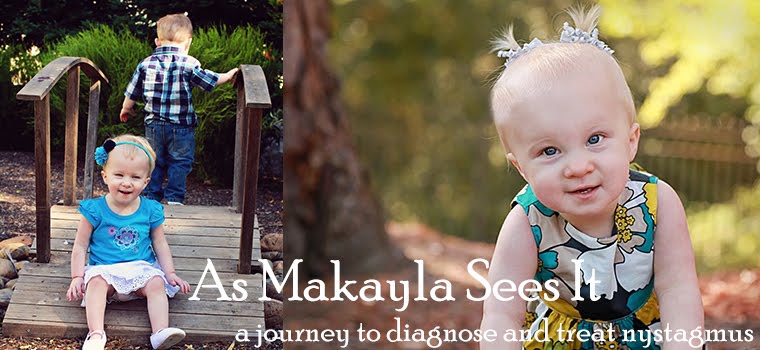During my conversation with the geneticist, she explained that it would be very unlikely that Makayla would have Ocular Albinism (OA) because it is something that is typically passed down only from mother's to their sons, and that Makayla is much more likely to have Oculocutaneous Albinism (OCA).
I was a little confused by this, because I had read and understood that Makayla could have OA if my husband and I both carried the recessive gene and that it's only passed from mother to son when the mother carries a dominant gene. I'm a science nerd with a particular interest in genetics, so I don't typically find myself lost when talking genes, but we agreed that we'll finish this genetics lesson when we meet in Novemeber. I am so looking forward to it!
*Here's a short blurb from the National Organization of Albinism and Hypopigmentation (NOAH) on the differences between OA and OCA and types of albinism:
Types of Albinism
While most people with albinism have very light skin and hair, not all do. Oculocutaneous (pronounced ock-you-low-kew-TAIN-ee-us) albinism (OCA) involves the eyes, hair and skin. Ocular albinism (OA), which is much less common, involves primarily the eyes, while skin and hair may appear similar or slightly lighter than that of other family members.
Over the years, researchers have used various systems for classifying oculocutaneous albinism. In general, these systems contrasted types of albinism having almost no pigmentation with types having slight pigmentation. In less pigmented types of albinism, hair and skin are cream-colored and vision is often in the range of 20/200. In types with slight pigmentation, hair appears more yellow or red-tinged and vision may be better. Early descriptions of albinism called these main categories of albinism “complete” and “incomplete” albinism. Later researchers used a test that involved plucking a hair root and seeing if it would make pigment in a test tube. This test separated “ty-neg” (no pigment) from “ty-pos” (some pigment). Further research showed that this test was inconsistent and added little information to the clinical exam.
Recent research has used analysis of DNA, the chemical that encodes genetic information, to arrive at a more precise classification system for albinism. Four forms of OCA are now recognized – OCA1, OCA2, OCA3 and OCA4; some are further divided into subtypes.
Researchers have also identified several other genes that result in albinism with other features. One group of these includes at least eight genes leading to Hermansky-Pudlak Syndrome (HPS). In addition to albinism, HPS is associated with bleeding problems and bruising. Some forms are also associated with lung and bowel disease. HPS is a less common form of albinism but should be suspected if a person with albinism shows unusual bruising or bleeding.
- Oculocutaneous albinism type 1 (OCA1 or tyrosinase-related albinism) results from a genetic defect in an enzyme called tyrosinase (hence ‘ty’ above). This enzyme helps the body to change the amino acid tyrosine into pigment. (An amino acid is a “building block” of protein.) There are two subtypes of OCA1. In OCA1A, the enzyme is inactive and no melanin is produced, leading to white hair and very light skin. In OCA1B, the enzyme is minimally active and a small amount of melanin is produced, leading to hair that may darken to blond, yellow/orange or even light brown, as well as slightly more pigment in the skin.
- Oculocutaneous albinism type 2 (OCA2 or P gene albinism) results from a genetic defect in the P protein that helps the tyrosinase enzyme to function. Individuals with OCA2 make a minimal amount of melanin pigment and can have hair color ranging from very light blond to brown.
- Oculocutaneous albinism type 3 (OCA3) is rarely described and results from a genetic defect in TYRP1, a protein related to tyrosinase. Individuals with OCA3 can have substantial pigment.
- Oculocutaneous albinism type 4 (OCA4) results from a genetic defect in the SLC45A2 protein that helps the tyrosinase enzyme to function. Individuals with OCA4 make a minimal amount of melanin pigment similar to persons with OCA2.

